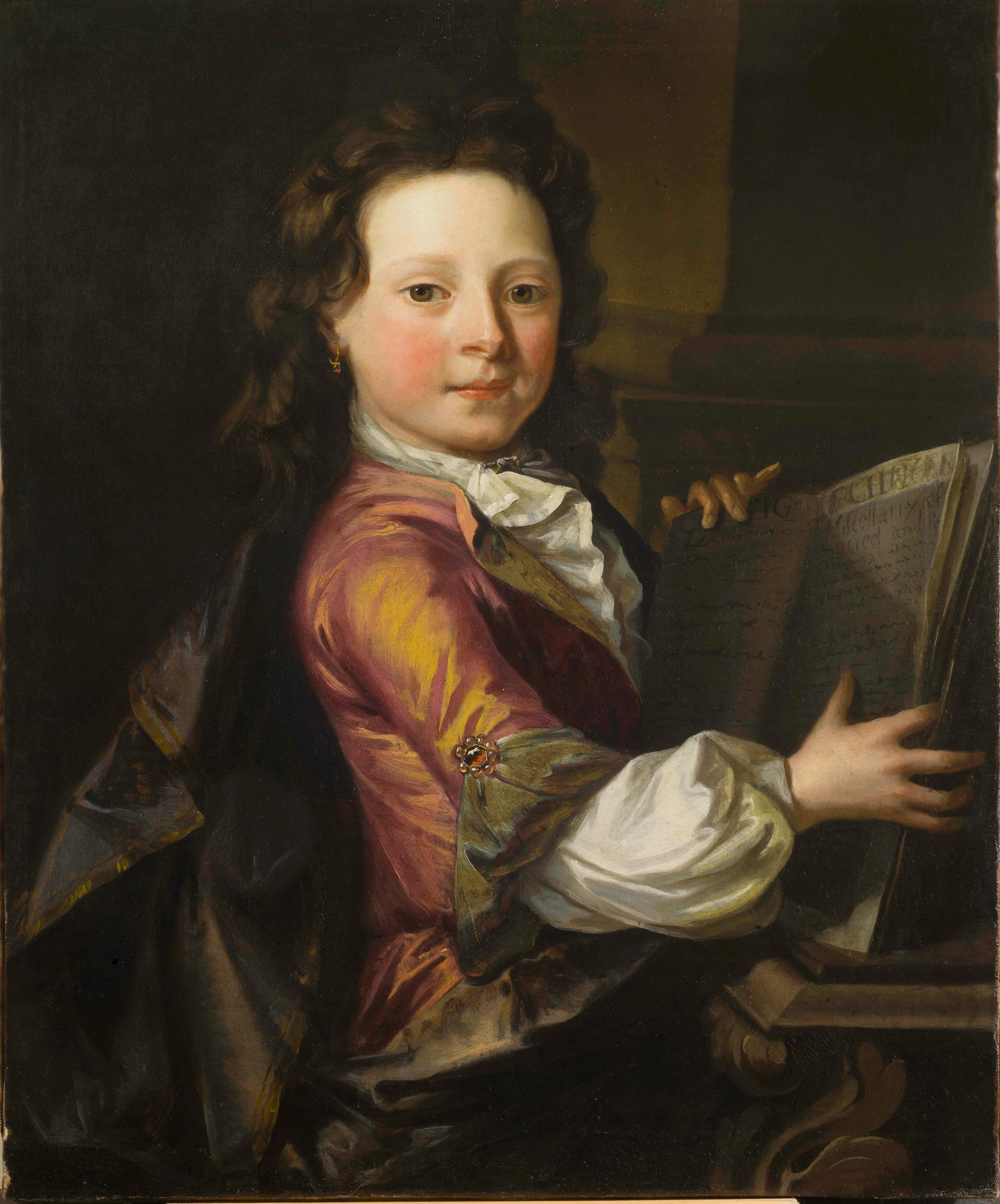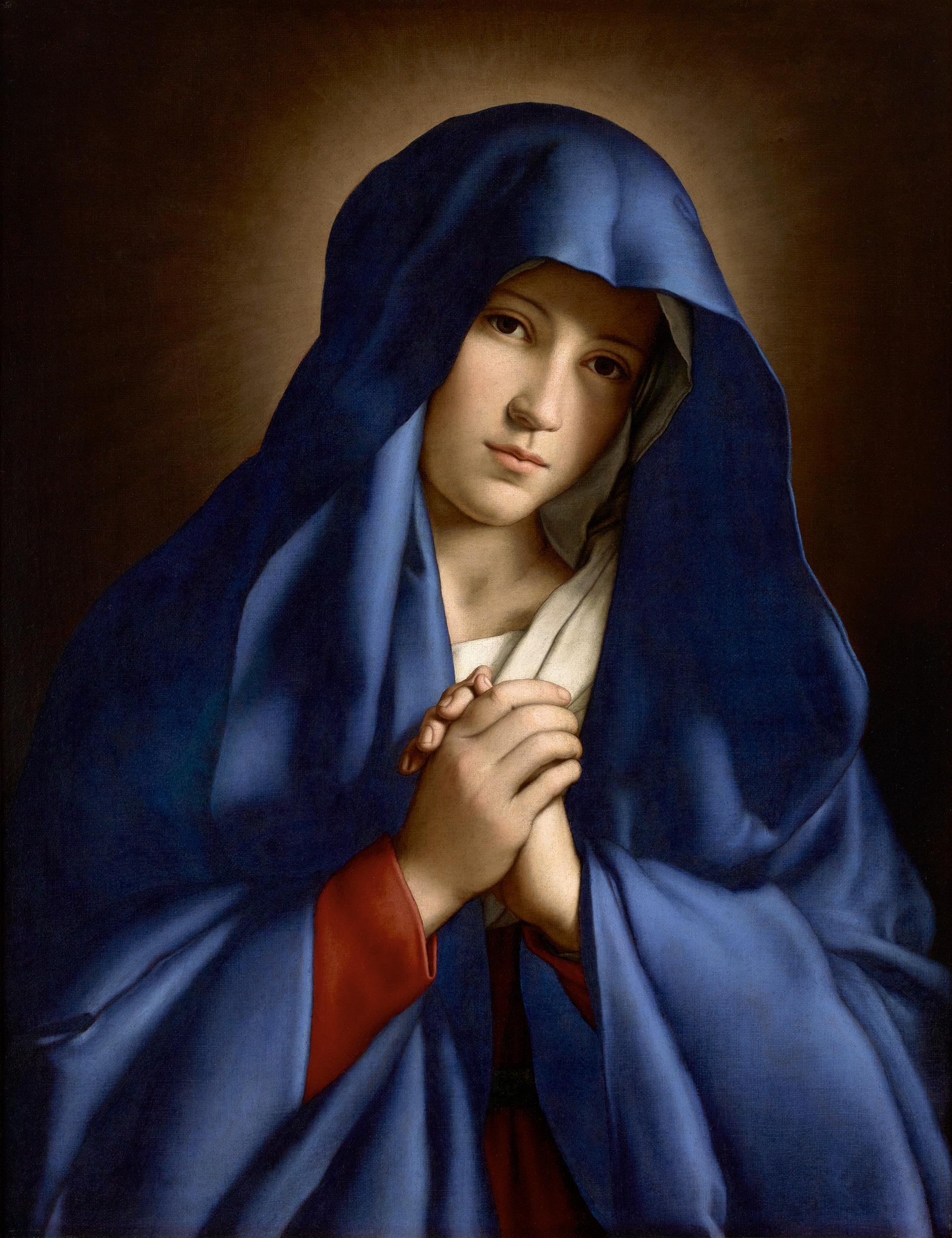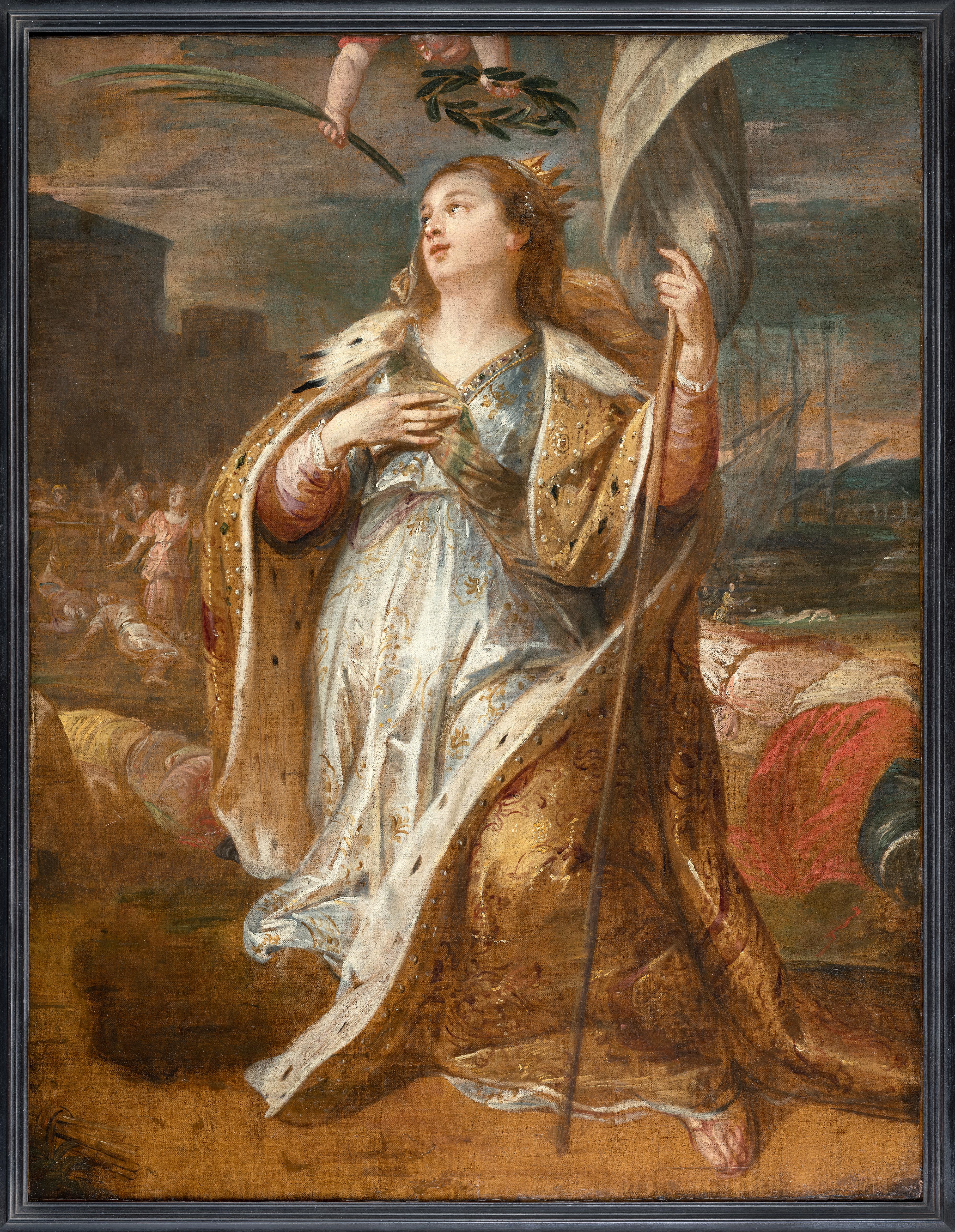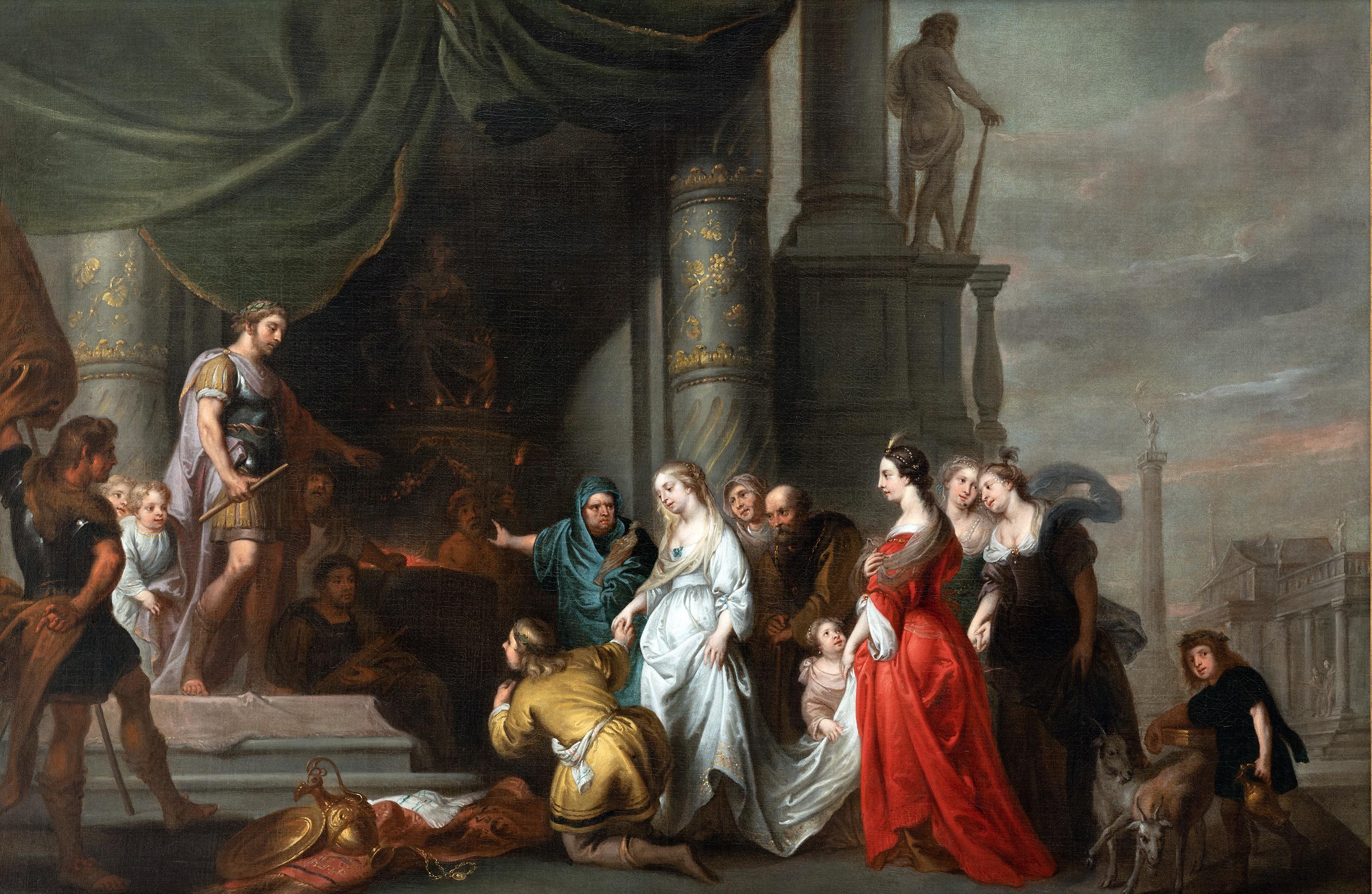Items Similar to English 17th century portrait of a lady in an ivory silk gown on a terrace
Want more images or videos?
Request additional images or videos from the seller
1 of 12
John GreenhillEnglish 17th century portrait of a lady in an ivory silk gown on a terracec.1670
c.1670
About the Item
Portrait of a 17th century lady, three-quarter length, in an ivory silk gown standing on a garden terrace.
The lady, painted circa 1670, gestures with her hand towards the gardens and land beyond off her country estate, wearing a sumptuous ivory silk gown adorned with pearls and precious stones and pearl earrings and necklace, signaling her wealth and status. She wears a ring on her left hand, which combined with her pale gown possibly alludes to her recent marriage. There are traces of a signature in ligature 'JG' in a lower fold of the sitter's right hand sleeve.
John Greenhill was a highly skilled and talented painter whose life and career were cut tragically short. He was born in Salisbury circa 1644 and was the son of John Greenhill, a merchant and later the local registrar and Penelope Champneys of Orchardleigh, Somerset. Greenhill's early artistic training is unknown but it is believed his first portrait was of his uncle, James Abbot of Salisbury. He moved to London in 1662 and became a pupil of Sir Peter Lely, court painter to Charles II. At the start of his career, Greenhill was hard working and ambitious and according to George Vertue was considered to be 'the most excellent of Lely's disciples'. His style was clearly influenced by Lely and Van Dyck and he progressed rapidly to leave and form his own studio.
Although he painted a variety of sitters such as James Duke of York (Dulwich Picture Gallery) and John Locke and Anthony Ashley, earl of Shaftesbury, he greatly enjoyed being at the heart of the Covent Garden theatre scene and the company and social life surrounding it and painted a great many playwrights, actors and their circle. He painted in oils but also produced a great many sketches and drawings in chalk which had become very popular at the time.
According to the diarist George Vertue, this led Greenhill to lead what he described as a 'dissolute' lifestyle and on May 1676, while returning home one evening drunk from the Vine Tavern, he fell into the gutter in Long Acre, was carried home to his lodgings in Lincoln's Inn Fields and died the same night, aged only 31. He was buried in nearby St Giles-in-the Fields. He had married young and Peter Lely gave his widow and young family an annuity to live on.
Greenhill is recognized for his skill and talent in portrait painting and his early death make the few existing portraits that he produced extremely rare. He was described in an epitaph written by his friend, the writer and actress Aphra Behn as 'The famous Greenhill'. Another writer, Bainbrigg Buckeridge, wrote in his 'Essay towards an English school' of 1706 that had he not died young, the effect of his too free living, England might have boasted a Painter who according to his beginnings, could not have been much inferior to the very best of Foreigners... whom we have always so much encourag'd in the portrait way.
Provenance: Scottish Borders private collection
Literature:
Ellis Waterhouse, 'Dictionary of 16th and 17th century British Painters', 1981
Dethloff D, 'Greenhill, John (1644?–1676), portrait painter'. Oxford Dictionary of National Biography. online version, May 2021
- Creator:John Greenhill (1646 - 1676, English)
- Creation Year:c.1670
- Dimensions:Height: 47.64 in (121 cm)Width: 40.16 in (102 cm)
- Medium:
- Movement & Style:
- Period:
- Condition:
- Gallery Location:Bath, GB
- Reference Number:1stDibs: LU95212161172
About the Seller
5.0
Vetted Seller
These experienced sellers undergo a comprehensive evaluation by our team of in-house experts.
Established in 2002
1stDibs seller since 2015
36 sales on 1stDibs
Typical response time: 1 hour
Associations
The British Antique Dealers' AssociationLAPADA - The Association of Arts & Antiques DealersInternational Confederation of Art and Antique Dealers' Associations
- ShippingRetrieving quote...Ships From: Bath, United Kingdom
- Return PolicyA return for this item may be initiated within 3 days of delivery.
More From This SellerView All
- English 17th century portrait of a ladyBy Sir Peter LelyLocated in Bath, SomersetA 17th century English portrait of a lady by Sir Peter Lely (1618-1680), half-length in a painted feigned oval, wearing a green silk gown with chestnut coloured cloak over one shoulder, her fair hair curled in the fashionable ringlet style of the period. Oil on canvas in an English giltwood 'Lely' frame. We are grateful to Diana Dethloff and Catharine MacLeod (who are currently working on a Lely catalogue raisonné) for their confirmation of Lely as the artist from photograph analysis of this previously unidentified early work. Provenance: Private collection Nottingham until 2021 Mellors and Kirk sale December 2000, lot 1173 The sitter is likely to have been from an upper class or aristocratic family in court circles, who were the main source of Lely`s patronage. The simple composition serves to highlight the beauty of the sitter through portraying her pale decolletage and complexion, set against the gentle gaze of her blue eyes, the soft blush of her cheeks and her full red lips. Peter Lely (1618-1680) was originally of dutch origin and became Principle Painter to the King in 1661, following in the footsteps of Van Dyck who had died in 1641. He dominated the portrait painting scene in England for over 20 years, creating a distinctive 'court look' in his work which had a strong influence on many other artists. He had an extremely successful and popular portrait practice which meant that he soon had to develop production methods that could accommodate the high demand for portraits, and also for copies and versions of them which were given as gifts to family and courtiers. The use of studio assistants was a common practice for busy artists and as with Van Dyck, Lely is known to have used specialist assistants to execute particular parts of his paintings. Artists who worked in Lely`s studio included John Baptist Gaspars who specialised in drapery painting, William Wissing, John Greenhill...Category
17th Century Baroque Portrait Paintings
MaterialsOil, Canvas
- English 17th century portrait of John Ludford EsquireBy Mary BealeLocated in Bath, SomersetPortrait of John Ludford (1653-1681), wearing a lace jabot and brown and gold trimmed cloak in a feigned stone oval cartouche. Inscribed 'John Ludford, Esq, nat. 14th March 1653, Ob,...Category
Late 17th Century Baroque Portrait Paintings
MaterialsCanvas, Oil
- 18th century portrait painting of a boy playing with a spinning top on a terraceLocated in Bath, SomersetPortrait of a young boy, full-length in a blue velvet coat and breeches, standing on a stone terrace in a park landscape, playing with a spinning top....Category
1740s English School Portrait Paintings
MaterialsCanvas, Oil
- 18th century English portrait of a lady beside an urn, with a basket of flowersBy Tilly KettleLocated in Bath, SomersetPortrait of a lady wearing a white gown with a red cloak, pearls in her hair and draped over one shoullder, standing beside a classical urn with a basket of flowers, c.1765. The portrait is believed to be a companion portrait of a John (1741-1816) or James (1751-1807) Durno which is housed in an identical frame. The sitter is possibly either the wife of John who was Janes Byres of Stonywood or John and James's sister Elizabeth. (James never married). The Durno family were based around the Aberdeen area of Scotland and John was an advocate in the area and then later a customs official in Jamaica. James was a successful timber merchant, spending time in the Baltic before being made His Majesty's Consul in Memel, Prussia. The portrait is likely to have been painted before Tilly travelled to India in 1768, when John, Jane and Elizabeth would have been in their twenties. We are gtrateful to Mark Beattie for sharing his family knowlege and research on the portrait. Provenance: With W. C. Beattie in the mid 19th century, and by descent through the family Private collection, Kent With thanks to Hugh Belsey who has confirmed this to be the work of Tilly Kettle from photographs. Tilly Kettle (1735-1786) was born in London, the third of six children by Henry Kettle (c.1704-c.1773), a coach painter, and his wife Ann. He attended William Shipley...Category
18th Century Old Masters Portrait Paintings
MaterialsCanvas, Oil
- English 19th century portrait painting of a Pointer dog in a woodland landscapeBy John Frederick Herring Sr.Located in Bath, SomersetA black pointer in a woodland landscape by John Frederick Herring Senior, circa 1830. Oil on canvas in a giltwood frame. Provenance: Arthur Ackerman and Son Frost and Reed Blains, Bruton Place, London John Frederick Herring, born in London in 1795, was the son of a London merchant of Dutch parentage, who had been born overseas in America. The first eighteen years of Herring's life were spent in London, where his greatest interests were drawing and horses. In 1814, at the age of 18, he moved to Doncaster in the north of England, and by 1815, had married Ann Harris. His sons John Frederick Herring Jr., Charles Herring, and Benjamin Herring...Category
1830s Victorian Animal Paintings
MaterialsOil, Canvas
- 17th century portrait of a ladyBy Nicolaes MaesLocated in Bath, SomersetPortrait of a lady by Dutch Golden Age painter Nicolaes Maes (1634-1693). Half-length, within a feigned oval, the lady wears a pearl necklace and earrings, an ivory silk gown adorned...Category
17th Century Old Masters Portrait Paintings
MaterialsCanvas, Oil
You May Also Like
- Portrait of a Boy, John Closterman, Large English Portrait Art, Old MasterBy John ClostermanLocated in Greven, DEJohn Clostermann (Osnabrück 1660 - 1711 London) Portrait of a boy, maybe Charles Hinde Oil on canvas, 61 x 74,6 cm John Closterman (also Klosterman) was a portrait painter of the late 17th and early 18th centuries. He primarily portrayed English noblemen and European aristocratic families. His father was already an artist and he trained his son. In 1679 he went to Paris and studied with Francois de Troy. In 1681 he was in London and worked for the artist John Riley, whose studio he took over after his death. In 1696 he was invited to the Spanish court...Category
17th Century Baroque Figurative Paintings
MaterialsCanvas, Oil
- Madonna Addolorata By SassoferratoBy Giovanni Battista Salvi da SassoferratoLocated in New Orleans, LASassoferrato (Giovanni Battista Salvi) 1609-1685 Italian Madonna Addolorata Oil on canvas Celebrated Italian artist Sassoferrato and his moving religious imagery are the epitome ...Category
17th Century Baroque Figurative Paintings
MaterialsCanvas, Oil
- Boeckhorst, Rubens, Saint Ursula, Decorative Old Master, Woman, Baroque, FlemishBy Jan BoeckhorstLocated in Greven, DEJohann Boeckhorst (Münster 1604 - Antwerp 1668) Saint Ursula Oil on canvas, 112 x 86 cm Provenance: New York, Christe's, 20.3.1981, lot 88 (as Van Diepenbeeck's circle) The presen...Category
17th Century Baroque Figurative Paintings
MaterialsCanvas, Oil
- Head of a Classical Poet (Socrates?)By Pier Francesco MolaLocated in New York, NYProvenance: Possibly Antonio Amici Moretti, Rome, 1690 Roy Clyde Gardner, Union, Mississippi, 1970s until 2004; by whom given to: Mississippi Band of Choctaw Indians, 2004-2010 Lit...Category
17th Century Baroque Paintings
MaterialsCanvas, Oil
- Continence of Scipio, Erasmus Quellinus, School Rubens, Baroque Art, Old MasterBy Erasmus Quellinus the YoungerLocated in Greven, DEErasmus Quellinus The Continence of Scipio Oil on Canvas The painting is included in the Catalogue Raisonné of the artist. The Roman commande...Category
17th Century Baroque Figurative Paintings
MaterialsOil, Canvas
- Antique Flemish Baroque painting, 17th Century Portrait "Medici" Oil on canvas.By Justus SustermansLocated in Berlin, DEAntique Flemish Baroque painting, 17th century, portrait, Medici. Oil on canvas. The painting is probably attributed to the Flemish painter Justus Sustermns. Pictured is most likel...Category
17th Century Baroque Portrait Paintings
MaterialsOil, Canvas





